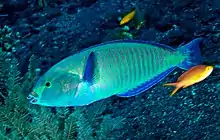Hologymnosus annulatus
Hologymnosus annulatus, the ring wrasse or ringed slender wrasse, is a species of marine ray-finned fish from the family Labridae, the wrasses, which has a wide Indo-Pacific distribution.[2]
| Hologymnosus annulatus | |
|---|---|
 | |
| adult | |
_(35894932271).jpg.webp) | |
| juveniles | |
| Scientific classification | |
| Kingdom: | Animalia |
| Phylum: | Chordata |
| Class: | Actinopterygii |
| Order: | Labriformes |
| Family: | Labridae |
| Genus: | Hologymnosus |
| Species: | H. annulatus |
| Binomial name | |
| Hologymnosus annulatus (Lacepède, 1801) | |
| Synonyms[2] | |
| |
Description
Hologymnosus annulatus has two colour forms which are geographically distinct, one in the Indian Ocean and the Red Sea and the other in the Pacific Ocean. In both forms the females are very dark, appearing almost black while the males are mostly greenish with a blue face. The males of the Indian form have a white band in the middle of the body, while the males of the Pacific form show a pale area on the caudal peduncle when breeding.[2] The body of the males is marked with numerous bluish-red bars and they frequently show a pale yellowish bar above the origin of the anal fin, the head is pale purplish in colour with green to blue-green bands radiating out from the eye, the one running to the snout broadens and branches.[3] Juvenile H. annulatus bear a close resemblance to the juveniles of Malacanthus latovittatus.[2] The juvelines are brown to olive brown and have 17-19 dark brown bars. They have a blue and black spot on gill cover, a black spot on side of lips with the spots on the lower lip being larger and the tail fin has a large whitish crescent near its end.[3]
Distribution
Hologymnosus annulatus is distributed from the Red Sea south along the eastern, Indian Ocean coast of Africa to South Africa east to the Society Islands and Pitcairn Island in the Pacific its range extends north to southern Japan and south to the Great Barrier Reef and Rapa Island.[1]
Habitat and biology
Hologymnosus annulatus occurs on coral reefs and areas of rocky substrate down to at least 30 metres (98 ft) on offshore reef slopes. The juveniles are normally solitary. It is a carnivore and its diet is mainly made up of small fishes, although it also eats crustaceans.[2] The juvelime fish frequent the bottom of the water column while the adults will swim relatively high in the water.[3] They are pelagic spawners.[2]
Species description
Hologymnosus annulatus was formally described in 1801 as Labrus annulatus by Bernard Germain de Lacépède in Volume 3 of his Histoire naturelle des poissons with the type locality given as Mauritius. Lacépède was following earlier work by Philibert Commerson.[4]
Human usage
Hologymnosus annulatus is collected for the aquarium trade and is harvested by small scale subsistence fisheries.[1]
References
- Yeeting, B. (2010). "Hologymnosus annulatus". IUCN Red List of Threatened Species. 2010: e.T187698A8604779. doi:10.2305/IUCN.UK.2010-4.RLTS.T187698A8604779.en. Retrieved 12 January 2020.
- Froese, Rainer and Pauly, Daniel, eds. (2019). "Hologymnosus annulatus" in FishBase. August 2019 version.
- "Hologymnosus annulatus". Fishes of Australia. Museums Victoria. Retrieved 12 January 2020.
- Eschmeyer, William N.; Fricke, Ron & van der Laan, Richard (eds.). "Labrus annulatus". Catalog of Fishes. California Academy of Sciences. Retrieved 12 January 2020.
External links
- http://www.fishbase.org/summary/5637
- Photos of Hologymnosus annulatus on Sealife Collection
